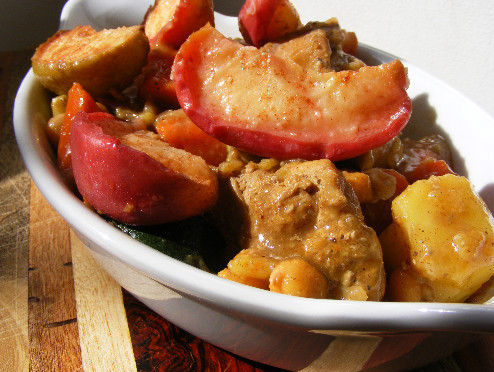Apple: Moroccan Chicken Apple Stew
Tuesday, October 19th, 2010Are you like the majority of Americans who only eat apples as a raw snack or in sweet dishes? If yes, you’re not alone – only a few years ago, I was the same.
More recently, I’ve taken cue from other cultures that use apples in savory dishes, much like one would use a potato – apples add a tart and sweet dimension to soups, stews and salads.
Last fall, I wrote about the Moroccan and North African cookery and how they use fruit such as apples, pears, quinces, apricots and raisins for savory dishes. This chicken and apple tagine is a twist of the Moroccan Lamb and Pear Tagine I posted. Of course, you could easily substitute pears or use both.
Although I still haven’t bought a tagine (the cooking vessel), this dish is a tagine – a reference to the rich Moroccan stew. The chicken version has more veggies (carrots, zucchini, and potatoes) and garbanzo beans. This is pure comfort food, especially when paired with couscous.
October is national apple month – so try apples in a savory dish. What’s your favorite non-sweet apple dish?
Tidbits on Apples:
- In 2004, U.S. per capita total apple consumption was 50.4 pounds per person, according to the U.S. Agriculture’s Economic Research Service. For fresh fruit, Americans eat 18.6 pounds of apples per person, second to bananas.
- The high pectin and malic acid in raw apples are good for digestion and elimination. Leave the skin on for extra nutritional benefits. The flavonoids found in apples are believed to help prevent cancer.
- The acid content of apples makes them a natural breath freshener.





